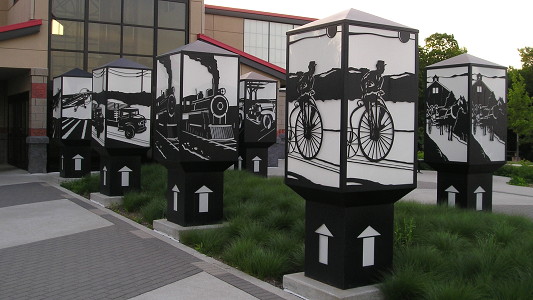
June 5, 2014: Various methods of getting places are shown at the I-35 southbound Story City rest area. Inside is a historic look at the highways of Story County — the Lincoln Highway, US 30, and I-35.
Rest areas are an integral part of the interstate highway system. They’ve been around since the beginning. But now, as many of the facilities in Iowa reach the end of their lifespans, the Iowa DOT is looking to eliminate some of them.
While long-haul truck drivers get safe parking at a rest area, for the typical driver, rest areas’ primary purpose is much more earthly — answering the call of nature. And after some time departed from home or a meal, with a fresh 32 ounces of pop involved, that call can be rather insistent. There’s a reason I referred to new US 20 in western Iowa as a “bladder buster” that has been alleviated only partially with a gas station at the IA 4 exit. Because Iowa doesn’t do true rest areas on non-interstates, it’s the best we’ll get.
With a rest area it’s easy: Take the short ramp, take a space, cross one door. Without, we’re talking about longer ramps, potential left turns, parking awkwardly at the front or side of a gas station, looking for directions to the middle or back of the building…and maybe finding a single-sex single-use facility already occupied*. Get in a more urban space and throw in stoplights, necessity of selecting a target, and maybe even more turns. And keep in mind I’m speaking as a solo driver, and not someone with one or more children in the back who really should have gone before we left.
And all of that is only if there’s something at the next exit. Unlike more-populated states, exits in Iowa without a town nearby rarely have a gas station, and almost never have more than one. It’s not quite as true as it was a decade ago, thanks to aggressive campaigns from Kum & Go/Pilot/Flying J/Love’s, but even so, I think the bulk of such cases are on I-80 between Iowa City and Davenport. I say gas station specifically because I can name the two interstate fast-food exceptions: The Burger King in the Middle of Nowhere (Northwood Welcome Center) and the Wendy’s in the Middle of Nowhere (I-29/IA 2 Welcome Center).
Around the turn of the century, the DOT began a slow redesign of Iowa’s rest areas to make each stop unique and reflective of the region’s history. It’s another function rest areas are well poised to serve. Here’s a report from 2003 showing the first changed ones. But two of the rest areas that have been praised for their design and educational components — the southbound I-29 welcome center at Sergeant Bluff and the southbound I-35 rest area at Story City — are on the proposed closure list. The I-29 rest area, with a Lewis and Clark theme, opened March 1, 2000; the I-35 rest area, celebrating Iowa transportation history, opened in 2009. Their lifespans would be wastefully cut short.
I can see the DOT closing the strictly parking-only areas. Those are freight-specific, for the most part, save for the scenic overlook near Story City (which, for all those who complain about I-35 in north-central Iowa, is a nice counterpoint). Adding semi parking spaces somewhere else could offset. But if you’re driving between Des Moines and Sioux City, and both the I-29 Missouri Valley and I-680 Loveland rest areas go away, between Adair and Onawa your options drop to a few gas stations, the Loveland overlook (WB only), and Missouri Valley McDonald’s. The I-680 rest areas rank at the bottom in usage because that is the least-traveled interstate in Iowa.
The one place where I’d say there was a misjudgment of location in the original rest area plan is the pair on I-80 at Davenport. The eastbound one is too close to the Illinois Welcome Center; the westbound one isn’t a welcome center; neither can serve I-74 or I-280 traffic. The best place would have been just west of I-280 … which happens to be where the World’s Largest Truckstop took root.
Rest areas are good places to check the weather and use the phone/Wi-Fi to make calls/look something up without doing so at 70 mph. (Plus, there are those hotel-coupon books, which can be surprisingly useful.) There’s also something to be said for the rest areas on the periphery of urban areas. They allow a driver who doesn’t want anything other than a pit stop a chance to get off and on easily without the rigamarole described above.
Nationally, between state budget cuts and commercialization advocates, rest areas are caught in a tug of war. Wisconsin kept its rest areas but shut down welcome center functions in 2009, leaving sad empty spaces at the US 61 and I-94 southern entrances to the state among others. A year ago, reporter Haley Byrd did a deep dive into a movement not to remove freeway rest stops but allow them to be turned into service plazas like on toll roads, which would go against an original rationale of the entire system.
Rest areas are designed to do a few things really well. To reduce their availability would, in my opinion, not serve the interest of a public highway system.
